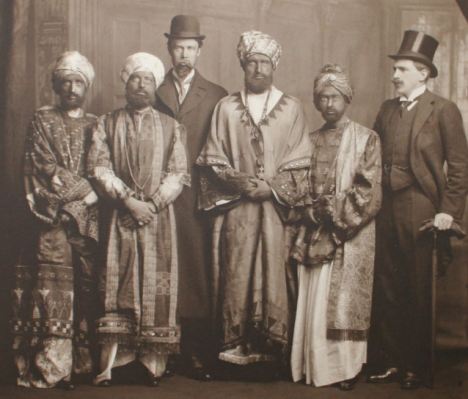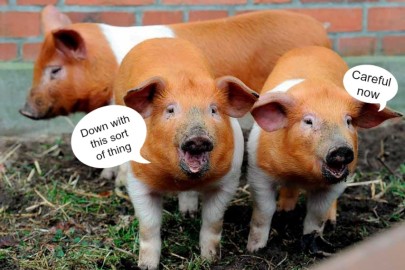This week’s weird Wikipedia article uncovers the silly student japes that brought the Bloomsbury Group to national attention…
The Dreadnought hoax was a practical joke pulled by Horace de Vere Cole in 1910. Cole tricked the Royal Navy into showing their flagship, the battleship HMS Dreadnought, to a fake delegation of Abyssinian royals. The hoax drew attention in Britain to the emergence of the Bloomsbury Group, among whom some of Cole’s collaborators numbered.
The hoax was a repeat of a similar impersonation which Cole and Adrian Stephen had organised while they were students at Cambridge in 1905. As a student prank, Cole’s idea was to pose as the Sultan of Zanzibar and make a state visit to Cambridge.
The Sultan was visiting England at the time and details had been published in the newspapers. A telegram was sent to the Mayor, ostensibly from a government official. Cole, Stephen and three other friends then dressed up in robes and turbans and arrived at the railway station where they were met by the Town Clerk who took them to an official reception by the Mayor at the Guildhall. After the reception, charity bazaar and tour of the sights, they were taken back to the station, where they made their escape. The story was then given to the Daily Mail by Cole and became quite famous at the time. The Mayor wanted the students sent down but was persuaded by the Vice-Chancellor that this would damage his reputation further.
The Dreadnought hoax was a similar impersonation which was suggested to Cole by a friend who was an officer on HMS Hawke, in order to hoax their rivals on HMS Dreadnought, including Commander Willie Fisher — Stephens’ cousin — who was on the staff of the Admiral. As Virginia Woolf later recounted
In those days the young officers had a gay time. They were always up to some lark; and one of their chief occupations it seemed was to play jokes on each other. There were a great many rivalries and intrigues in the navy. The officers like scoring off each other. And the officers of the Hawke and the Dreadnought had a feud. … And Cole’s friend who was on the Hawke had come to Cole, and said to him, ‘You’re a great hand at hoaxing people; couldn’t you do something to pull the leg of the Dreadnought?’
This involved Cole and five friends — Virginia Woolf, her brother Adrian Stephen, Guy Ridley, Anthony Buxton and artist Duncan Grant — who had themselves disguised by Willy Clarkson, with skin darkeners and turbans to resemble members of the Abyssinian royal family. The main limitation of the disguises was that the “royals” could not eat anything or their make-up would be ruined. Adrian Stephen took the role of “interpreter”. In the picture at the top of this post, Virginia Woolf is the bearded figure on the left.
On 7 February 1910 the hoax was set in motion. Cole organised for an accomplice to send a telegram to HMS Dreadnought which was then moored in Portland, Dorset. The message said that the ship must be prepared for the visit of a group of princes from Abyssinia and was purportedly signed by Foreign Office Under-secretary Sir Charles Hardinge. Cole with his entourage went to London’s Paddington station where Cole claimed that he was “Herbert Cholmondeley” of the UK Foreign Office and demanded a special train to Weymouth; the stationmaster arranged a VIP coach. In Weymouth, the navy welcomed the princes with an honour guard. An Abyssinian flag was not found, so the navy proceeded to use that of Zanzibar and to play Zanzibar’s national anthem.
The group inspected the fleet. To show their appreciation, they communicated in a gibberish of words drawn from Latin and Greek; they asked for prayer mats and attempted to bestow fake military honours on some of the officers. Commander Fisher failed to recognise either of his cousins.
When the prank was uncovered in London, the ringleader Horace de Vere Cole contacted the press and sent a photo of the “princes” to the Daily Mirror. The group’s pacifist views were considered a source of embarrassment, and the Royal Navy briefly became an object of ridicule. The Navy later demanded that Cole be arrested. However, Cole and his compatriots had not broken any law. The Navy sent two officers to cane Cole as a punishment but Cole countered that it was they who should be caned because they had been fooled in the first place.
During the visit to Dreadnought, the visitors had repeatedly shown amazement or appreciation by exclaiming “Bunga! Bunga!”. In 1915 during the First World War, HMS Dreadnought rammed and sank a German submarine. Among the telegrams of congratulation was one that read “BUNGA BUNGA”.












Wonderful, one of the best examples of the art of the prank I’ve heard of. No injury, damage or personal humiliation, but authority left highly embarassed and demanding punishment and legal sanctions when all are laughing at them and no laws were broken.
Until now, the best I’d heard of was here about forty-five years ago. The Canadian football championship game alternated annually between Toronto and Vancouver, with week-long festivities leading up to the game. The most rabid fans came from Saskatchewan, also known for its rural cowboy culture. Saskatchewan was in the game that year and a group of students from Montreal arranged secretly to pick-up horses and cowboy clothes on the west side of Toronto and then ride downtown with great fanfare and actually into the lobby of the best-known hotel, claiming they had ridden all the way from Saskatchewn ( about1,500 miles) for the party and game. Only to be told, of course, that the game that year was in Vancouver, 1500 miles in the other direction. The media bought the whole country rube schtick and they managed to be front page fare until they fessed up after a couple of days.
It’s interesting that they apparently didn’t break any laws, because I can, off the top of my head, think of three crimes involved in any modern repeat of the dreadnought hoax (impersonation of a government official; theft of services; criminal trespass).
Just reading Skidelsky’s abridged single volume biography of Keynes. Duncan Grant was Keynes lover at the time of the hoax and Keynes on learning about the exploit wrote to Grant “What a lunatic affair! Are you going to jail for it?”. Skidelsky describes him as enquiring ‘anxiously’ so perhaps it was a real fear. Anyhow, friends in high places meant it was dismissed as “high jinks” (trans. upper class criminality that because of its source is trivialised and overlooked.).
Yep, I don’t think upper class twits could actually break the law in those days, short of murdering someone